engine AUDI Q5 2015 Repair Manual
[x] Cancel search | Manufacturer: AUDI, Model Year: 2015, Model line: Q5, Model: AUDI Q5 2015Pages: 302, PDF Size: 75.01 MB
Page 201 of 302
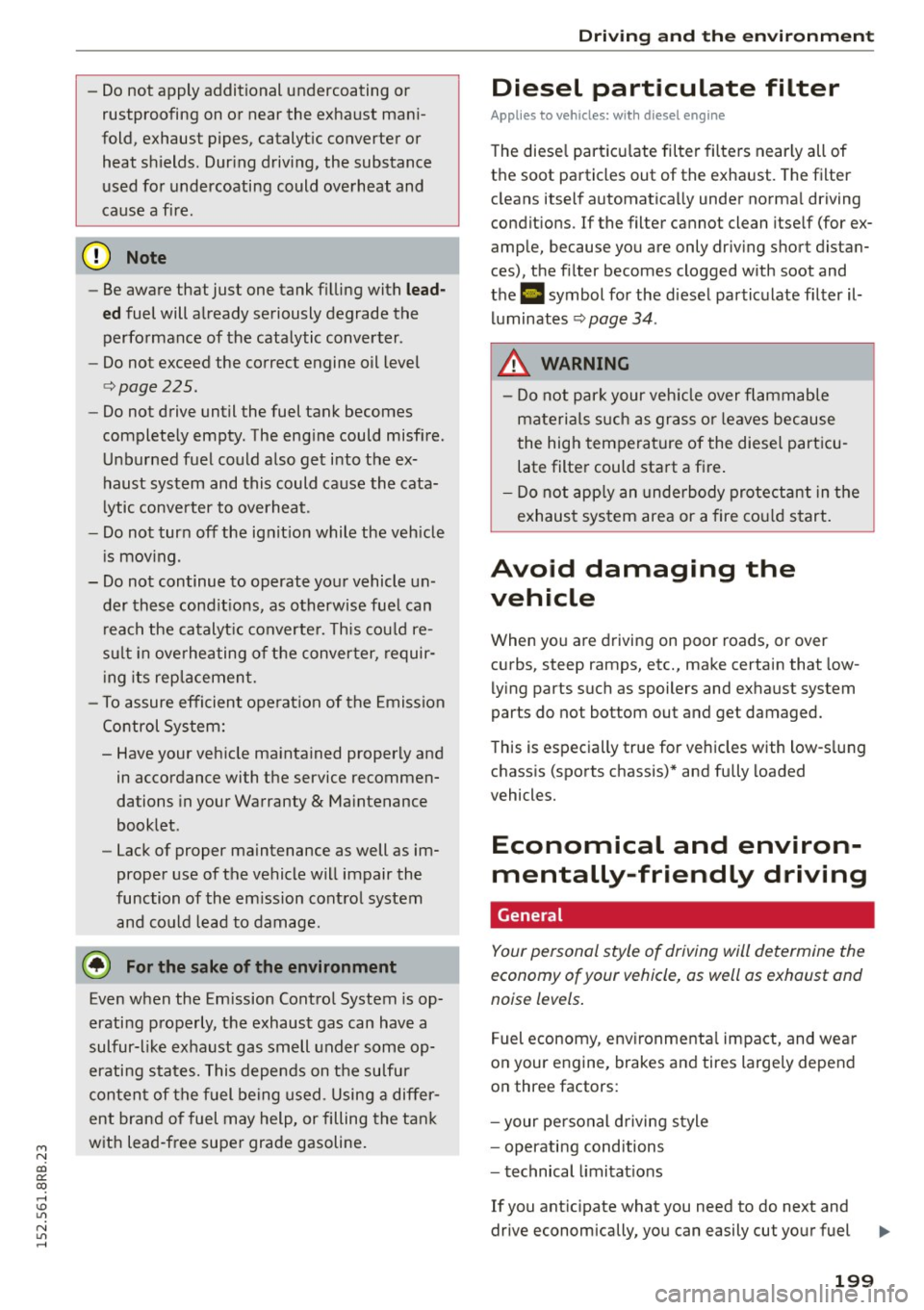
M N
co
a:
co
,...., \!) 1.1'1
N 1.1'1 ,....,
-Do not apply additional undercoating or
rustproofing on or near the exhaust man i
fold, exhaust pipes, catalytic converter or heat shields. During driving, the substance
used for undercoating could overheat and
cause a fire.
Q) Note
- Be aware that just one tank filling with lead
ed
fuel will already seriously degrade the
performance of the catalytic converter .
- Do not exceed the correct engine oil level
¢page 225.
-Do not drive until the fuel tank becomes
completely empty . The engine could misfire.
Unburned fuel could also get into the ex
haust system and this could cause the cata
l ytic converter to overheat.
- Do not turn off the ignit ion while the veh icle
i s mov ing .
- Do not continue to operate your vehicle un
der these cond it ions, as otherwise fuel can
reach the catalyt ic converte r. This cou ld re
su lt in overheating of the converter, requir
i ng its replacement.
- To assure efficient operat ion of the Emission
Control System:
- Have your veh icle maintained properly and
in accordance with the service recommen
dations in your Warranty
& Maintenance
booklet.
- Lack of proper maintenance as well as im
proper use of the vehicle will impair the
function of the em ission control system
and could lead to damage.
@) For the sake of the environment
Even when the Em ission Control System is op
erating properly, the exhaust gas can have a
sulfur-like exhaust gas smell under some op
erating states. This depends on the sulfu r
content of the fuel being used. Using a differ
ent brand of fuel may help, or filling the tank
wit h lead-free super grade gasoline.
Dri ving and th e en vir onm ent
Diesel particulate filter
Applies to veh icles: w ith diesel en gine
The diese l particu late filter filters nearly all of
the soot particles out of the exhaust. The filter
cleans itself automatica lly under norma l driving
conditions. If the filter cannot clean itself (for ex
ample, because you are only driving short distan
ces), the filter becomes clogged with soot and
the
II symbol for the diese l particulate filter il
luminates
¢ page 34 .
_&. WARNING
-Do not park your veh icle over flammab le
materia ls such as grass or leaves because
the high temperature of the diesel particu
late filter could start a fire .
-
-Do not app ly an underbody protectant in the
exhaust system area or a fire cou ld start.
Avoid damaging the
vehicle
When you are driving on poor roads, or over
curbs, steep ramps, etc., make certain that low
lying parts such as spoilers and exhaust system
parts do not bottom out and get damaged.
This is especially true for vehicles with low-slung
chassis (sports chassis)* and fully loaded
vehicles.
Economical and environ
mentally-friendly driving
General
Your personal style of driving will determine the
economy of your vehicle, as well as exhaust and
noise levels.
Fuel economy, environmenta l impact, and wear
on your engine, brakes and tires largely depend
on three factors:
- your pe rsonal d riving style
- operating conditions
- technical limitat ions
If you ant icipate what you need to do next and
drive economically, you can easily cut your fuel
199
Page 202 of 302
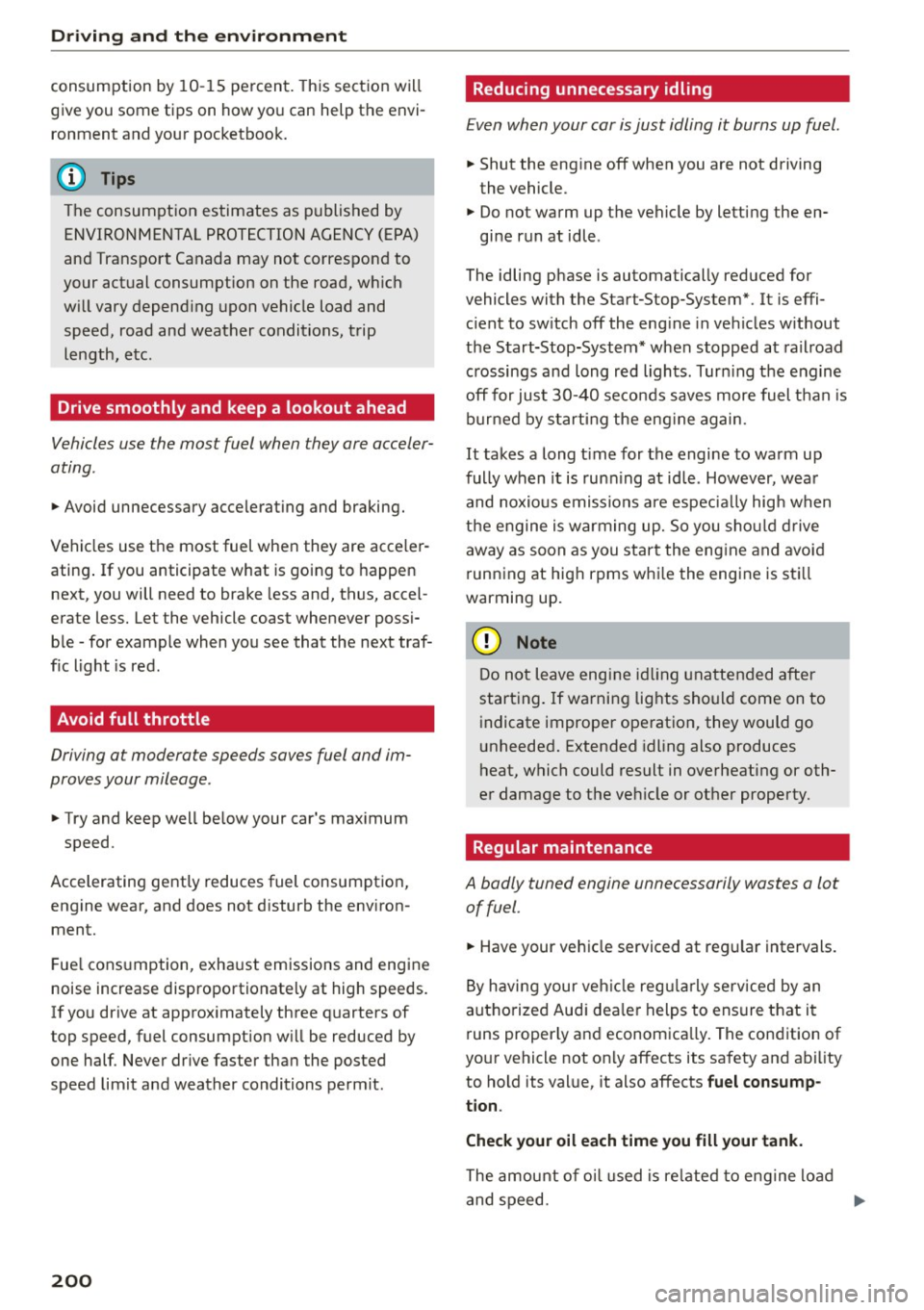
Driving and th e environment
consumption by 10-15 percent. This section will
give you some tips on how you can help the envi ronment and your pocketbook.
(D Tips
The consumption estimates as published by ENVIRONMENTAL PROTECTION AGENCY (EPA)
and Transport Canada may not correspond to
your actual consumption on the road, wh ich
w ill vary depend ing upon vehicle load and
speed, road and weather conditions, trip
length, etc .
Drive smoothly and keep a lookout ahead
Vehicles use the most fuel when they are acceler
ating .
"'Avoid unnecessary accelerating and braking.
Vehicles use the most fuel when they are acceler
ating . If you anticipate what is going to happen
next, you will need to brake less and, thus, accel
erate less. Let the vehicle coast whenever possi
ble -for example when you see that the next traf
fic light is red .
Avoid full throttle
Driving at moderate speeds saves fuel and im
proves your mileage.
"' Try and keep well be low your car's max imum
speed.
Accelerating gently reduces fuel consumption,
engine wear, and does not disturb the environ
ment.
Fue l consumption, exhaust emissions and engine
noise increase disproportionately at high speeds.
If you drive at approximately three quarters of
top speed, fuel consumpt ion w ill be reduced by
one half. Never dr ive faster than the posted
speed lim it and weather conditions permit .
200
· Reducing unnecessary idling
Even when your car is just idling it burns up fuel .
"'Shut the engine off when you are not driving
the vehicle.
"' Do not warm up the vehicle by letting the en-
gine run at idle .
The idling phase is automatically reduced for
vehicles with the Start-Stop-System*. It is effi c ient to sw itch off the eng ine in vehicles w ithout
the Start-Stop-System* when stopped at railroad
crossings and long red lights. Turn ing the engine
off for just 30-40 seconds saves more fuel than is
burned by start ing the eng ine again.
It takes a long t ime for the engine to warm up
fully when it is runn ing at id le . However, wear
and noxious emissions are especia lly high when
the engine is warming up. So you sho uld drive
away as soon as you start the eng ine and avoid
running at high rpms whi le the engine is s till
warming up.
Q) Note
Do not leave engine id ling unattended after
starting. If warning lights should come on to
indicate improper operation, they would go
unheeded. Extended idling also produces
heat, which could result in overheating or oth
er damage to the veh icle or other property.
· Regular maintenance
A badly tuned engine unnecessarily wastes a lot
of fuel.
"' Have your vehicle serviced at regu lar intervals.
By having your veh icle reg ularly serv iced by an
authorized Aud i dea le r helps to ensure that i t
runs proper ly and economica lly. The condition of
your vehicle not on ly affects its safety and ability
to hold its value, it also affects
fuel consump
t ion .
Chec k your oil ea ch t ime y ou fill your tank.
The amount of o il used is re lated to engine load
and speed. .,.
Page 203 of 302
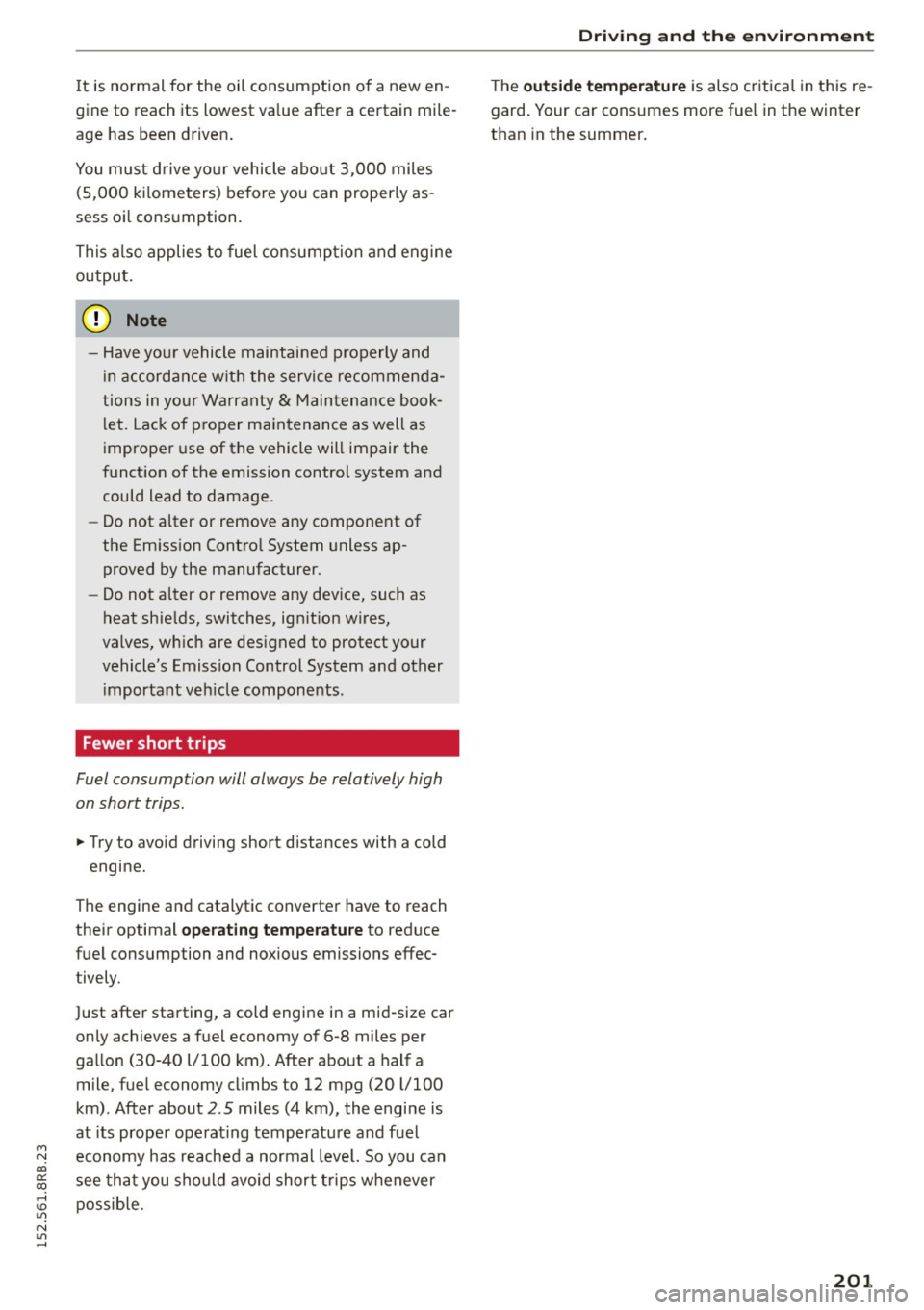
M N
co
a:
co
,...., \!) 1.1'1
N 1.1'1 ,....,
It is normal for the oil consumption of a new en
gine to reach its lowest va lue after a certain mile
age has been driven.
You must d rive yo ur vehicle about 3,000 miles
(5,000 kilometers) before you can properly as
sess oi l consumption.
This also applies to fuel consumption and engine
output.
(y Note
- Have you r vehicle maintained properly and
in accordance with the service recommenda
tions in your Warranty
& Maintenance book
l et. Lack of proper maintenance as well as
improper use of the vehicle will impair the
funct ion of the emission control system and
could lead to damage.
- Do not alter or remove any component of
the Emission Contro l System unless ap
proved by the manufacturer.
- Do not alter or remove any device, such as
heat shields, switches, ign it ion w ires,
valves, wh ich are designed to protect your
vehicle's Emission Control System and other i mportant vehicle components.
Fewer short trips
Fuel consumption will always be relatively high
on short trips .
.. Try to avoid driving short distances with a cold
engine.
The engine and catalytic converter have to reach
their optimal
operating temperature to reduce
fuel consumption and noxious emissions effec
tively.
Just after starting, a cold engine in a mid-size car
only achieves a fuel economy of 6-8 miles per
gallon (30-40 l/100 km). After about a half a
mile, fuel economy cl imbs to 12 mpg (20 l/100
km) . After about
2.5 miles (4 km), the engine is
at its proper operating temperature and fuel
economy has reached a normal level. So you can
see that you should avoid short trips whenever
possib le.
Driving and the environment
The outside temperature is also critical in this re
gard. Your car consumes more fuel in the winter
than in the summer.
201
Page 205 of 302
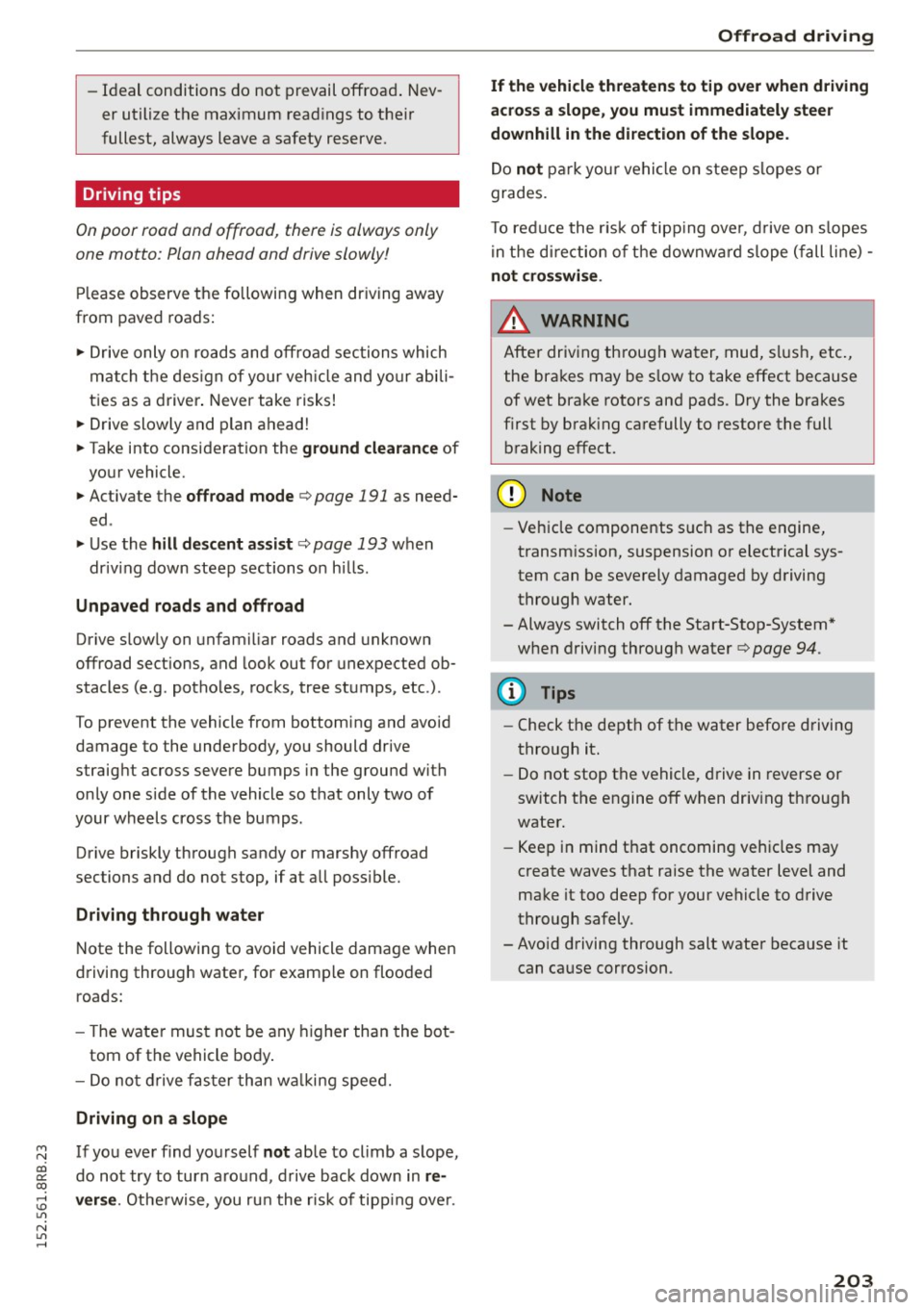
M N
co
a:
co
,...., \!) ..,.,
N ..,., ,....,
-Ideal conditions do not prevail offroad . Nev
er utilize the maximum read ings to their
fullest, always leave a safety reserve.
Driving tips
On poor road and offroad, there is always only
one motto: Plan ahead and drive slowly!
P lease observe the followin g when driving away
from paved roads :
~ Drive only on roads and off road sections which
match the des ign of your veh icle and yo ur abili
t ies as a driver . Never take risks!
~ Drive slowly and plan ahead!
~ Take into consideration the gr ou nd cle aran ce of
your vehicle.
~ Activate the offroad mode c> page 191 as need
ed .
~ Use the hill des cent a ssi st <=:> page 193 when
dr iv ing down steep sections on hi lls.
Unp aved roads and offroad
Drive s low ly on unfami liar roads and unknown
offroad sections, and look out for unexpected ob
stacles (e.g . potho les, rocks, tree stumps, etc .) .
T o prevent the vehicle from bottoming and avoid
damage to the underbody, you should drive
straight across severe bumps in the ground with
only one side of the vehicle so that only two of
your wheels cross t he bumps.
Drive briskly through sandy or marshy offroad
sections and do not stop, if at all poss ible.
Driving through water
Note the following to avoid vehicle damage when
driving through water, for example on flooded roads:
- The water must not be any higher than the bot-
tom of the vehicle body .
- Do no t d rive fas ter than wa lking speed.
Driving on a slope
If you ever find yourself not ab le to climb a s lope,
do not try to turn around, drive back down in
re
ver se.
Othe rwise, you ru n the r isk of tipp ing ove r.
O ffro ad dri vin g
If the vehicle th reaten s to tip over when driving
acro ss a slope, you must immediately stee r
downhill in the direction of the slope.
Do not park you r vehi cle on steep s lopes or
grades.
T o reduce the risk of tipp ing ove r, d rive on s lopes
i n the d irection of t he downwa rd s lope (fall li ne) -
not cro sswi se .
& WARNING ~ -
After driving th rough water, mud, s lush, etc.,
the bra kes may be s low to take effect because
of wet bra ke rotors and pads. Dry the brakes
f irst by brak ing carefully to restore the full
braking effect.
(D Note
- Veh icle components s uch as the engine,
transm ission, suspension or electrical sys
tem can be severely damaged by driving
through water.
- Always switch off the Start-Stop-System *
when drivi ng throug h water
r=> page 94.
(D Tips
- Check t he depth of the water before driving
through it.
- Do not stop the vehicle, drive in reverse or
switch the engine off when driv ing through
water.
- Keep i n mind that oncoming veh icles may
create waves that raise the water level and
make it too deep for your vehicle to drive
through safely .
-Avo id driving through salt wate r because it
can cause corrosion .
203
Page 207 of 302
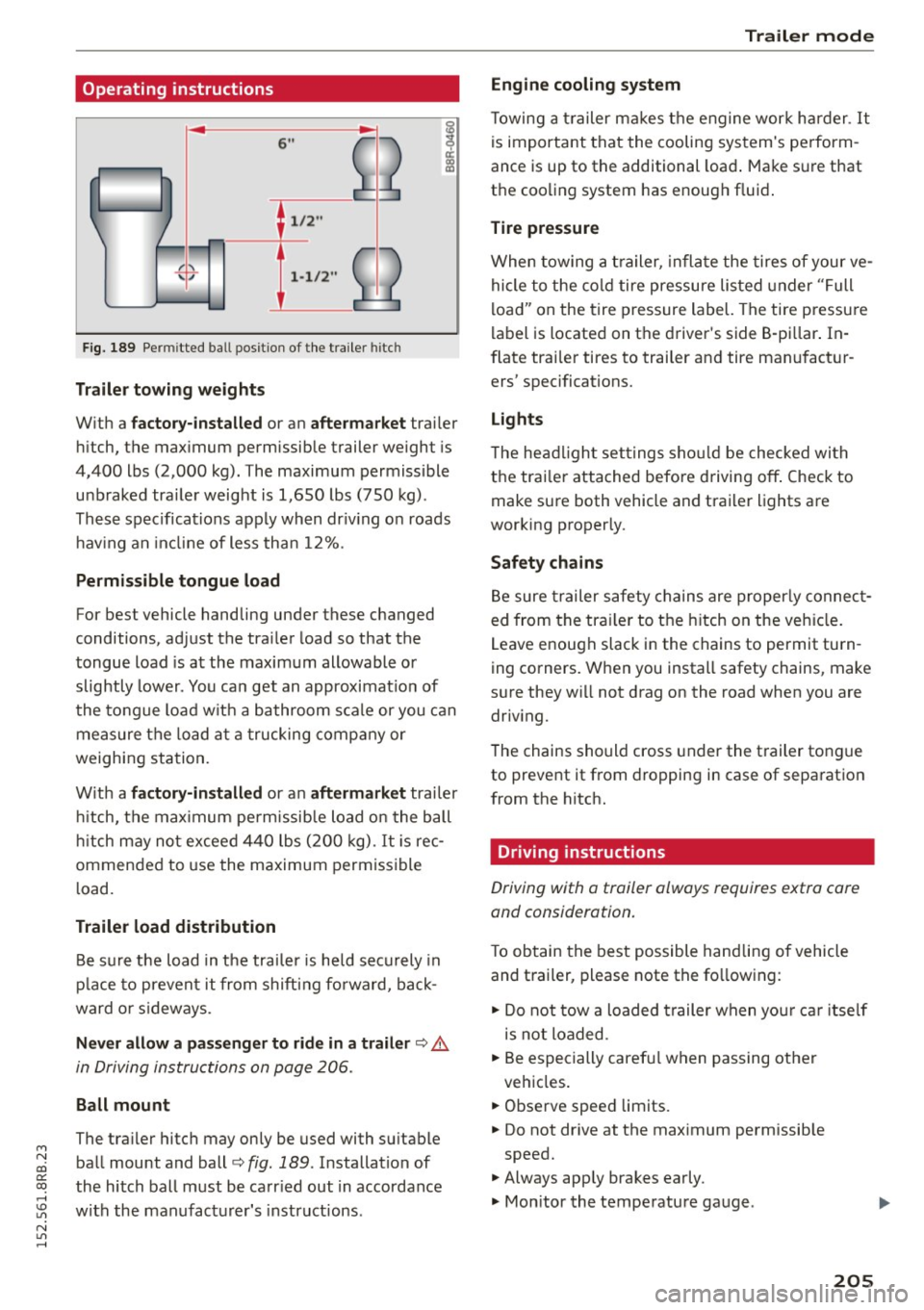
M N
co
a:
co
,...., \!) Ll"I
N Ll"I ,....,
Operating instructions
6"
~
a
2
. 1/2"
'
-{ I} 1-1/2"
-
Fig. 189 Pe rmi tted ba ll pos it ion of the trailer hitc h
Trailer towing weights
With a factory-installed or an aftermarket trailer
hitch, the maximum permissible trailer weight is
4,400 lbs (2,000 kg) . T he maximum permissible
unbraked trailer weight is 1,650 lbs (750 kg) .
These specifications apply when dr iv ing on roads
having an inclin e of less than 12%.
Permissible tongue load
For best vehicle handling under these changed
conditions, adjust the traile r load so that the
tongue load is at the maximum allowable or
slightly lower. You can get an approximat ion of
the tongue load w ith a bathroom scale or you can
measure the load at a trucking company or
weighing station.
With a
factory-installed or an aftermarket trailer
hitch, the maximum permissible load on the ball
hitch may not exceed 440 lbs (200 kg). It is rec
ommended to use the maximum permissible
l oad.
Trailer load distribution
Be sure the load in the tra iler is held securely in
place to prevent it from shifting forward, back
ward or sideways .
Never allow a passenger to ride in a trailer c::> .&.
in Driving instructions on page 206.
Ball mount
The trailer hitch may only be used with suitable
ball mount and ball
c::> fig. 189 . Installation of
the hitch ball must be carr ied out in accordance
with the manufacturer's instructions .
Trailer mode
Engine cooling system
Towing a trailer makes the engine work harder . It
is important that the cooling system's perform
ance is up to the additional load . Make s ure that
the cooling system has enough fluid .
Tire pressure
When towing a trailer, inflate the tires of your ve
hicle to the cold tire pressure listed under "Full
load" on the tire pressure label. The tire pressure
label is located on the driver's side B·pillar. In·
flate trailer tires to trailer and tire manufactur
ers' specifications.
Lights
T he headlight settings sho uld be checked with
the trai ler attached before driving off. Check to
make sure both vehicle and trailer lights are
working properly.
Safety chains
Be sure trailer safety chains are properly connect
ed from the trailer to the hitch on the vehicle.
Leave enough slack in the chains to permit turn
ing corners. When you install safety chains, make
sure they w ill not drag on the road when you are
driving.
The chains should cross under the trailer tongue
to prevent it from dropping in case of separation
from the hitch.
Driving instructions
Driving with o trailer always requires extra core
and consideration .
To obtain the best possible handling of vehicle
and trailer, please note the fo llowing :
.. Do not tow a loaded trailer when your car itse lf
is not loaded.
.. Be especially careful when passing other
vehicles .
.. Observe speed lim its .
.. Do not drive at the maximum permissible
speed.
.. Always apply brakes early .
.. Mon itor the temperature gauge .
205
Page 208 of 302
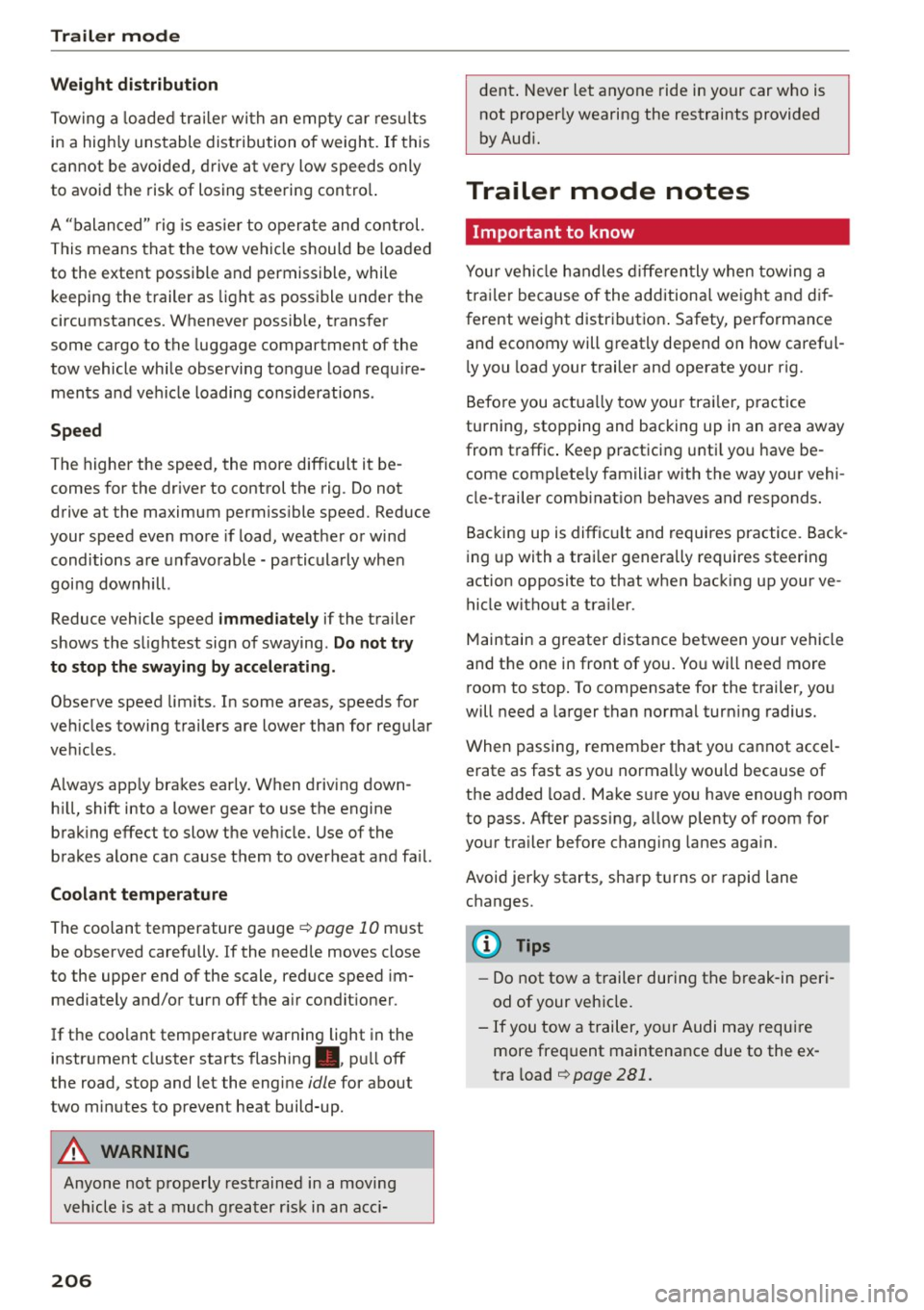
Trailer mode
Weight distribution
Towing a loaded trai ler with an empty car res ults
in a high ly unstable distribution of weight. If this
cannot be avoided , drive at very low speeds only
to avoid the risk of losing steering contro l.
A "balanced" rig is easier to operate and control.
This means that the tow vehicle should be loaded
to the extent possible and permissible, while
keeping the trailer as light as possible under the
circumstances. Whenever possible, transfer
some cargo to the luggage compartment of the
tow vehicle while observing tongue load require
ments and vehicle loading considerations .
Speed
The higher the speed, the more difficult it be
comes for the driver to control the rig . Do not
drive at the maximum permiss ible speed. Reduce
your speed even more if load, weathe r or wind
conditions are unfavorable - particularly when
going downhill.
Reduce vehicle speed
immediately if the trailer
shows the s lightest sign of swaying .
Do not try
to stop the swaying by accelerating.
Observe speed limits. In some areas, speeds for
veh icles towing trailers are lower than for regular
ve hicles .
A lways app ly brakes ear ly. When driving down
hill, shift into a lower gear to use the engine
brak ing effect to slow the vehicle. Use of the
brakes alone can cause them to overheat and fa il.
Coolant temperature
The coolant temperature gauge c::> page 10 must
be observed carefully.
If the need le moves close
to the upper end of the scale, reduce speed im
mediately and/or turn off the a ir condit ioner.
If the coo lant temperature warning light in the
instr ument cluster starts flashing •• pu ll off
the road, stop and let the engine
idle for about
two minutes to prevent heat build-up.
A WARNING
Anyone not properly restrained in a moving
vehicle is at a much greater r isk in an acc i-
206
-
dent. Never let anyone ride in your car who is
not properly wearing the restraints provided
by Audi.
Trailer mode notes
Important to know
Your vehicle handles differently when towing a
trai ler because of the additiona l weight and dif
ferent we ight distribution . Safety, performance
and economy will greatly depend on how careful
l y you load your trailer and operate your rig.
Before you actua lly tow your trai ler, practice
turning, stopping and backing up in an area away
from traffic . Keep practicing until you have be
come comp lete ly familiar with the way your vehi
cle-trailer comb inat ion behaves and responds.
Backing up is difficult and requires practice. Back
ing up with a trai ler generally requires steering
action opposite to that when backing up your ve
hicle without a tra iler.
Maintain a greater distance between your vehicle
and the one in front of you. Yo u will need more
room to stop. To compensate for the trailer, you
will need a larger than normal turn ing radius.
When passing, remember that you cannot accel
erate as fast as you norma lly wou ld because of
the added load. Make sure you have enough room
to pass. After passing, allow plenty of room for
your tra iler before changing lanes again.
Avoid jerky starts , sharp t urns or rapid lane
changes.
@ Tips
- Do not tow a trailer during the break-in peri
od of your vehicle.
- If you tow a trailer, your Audi may requi re
more frequent maintenance due to the ex
tra load
c::> page 281.
Page 215 of 302
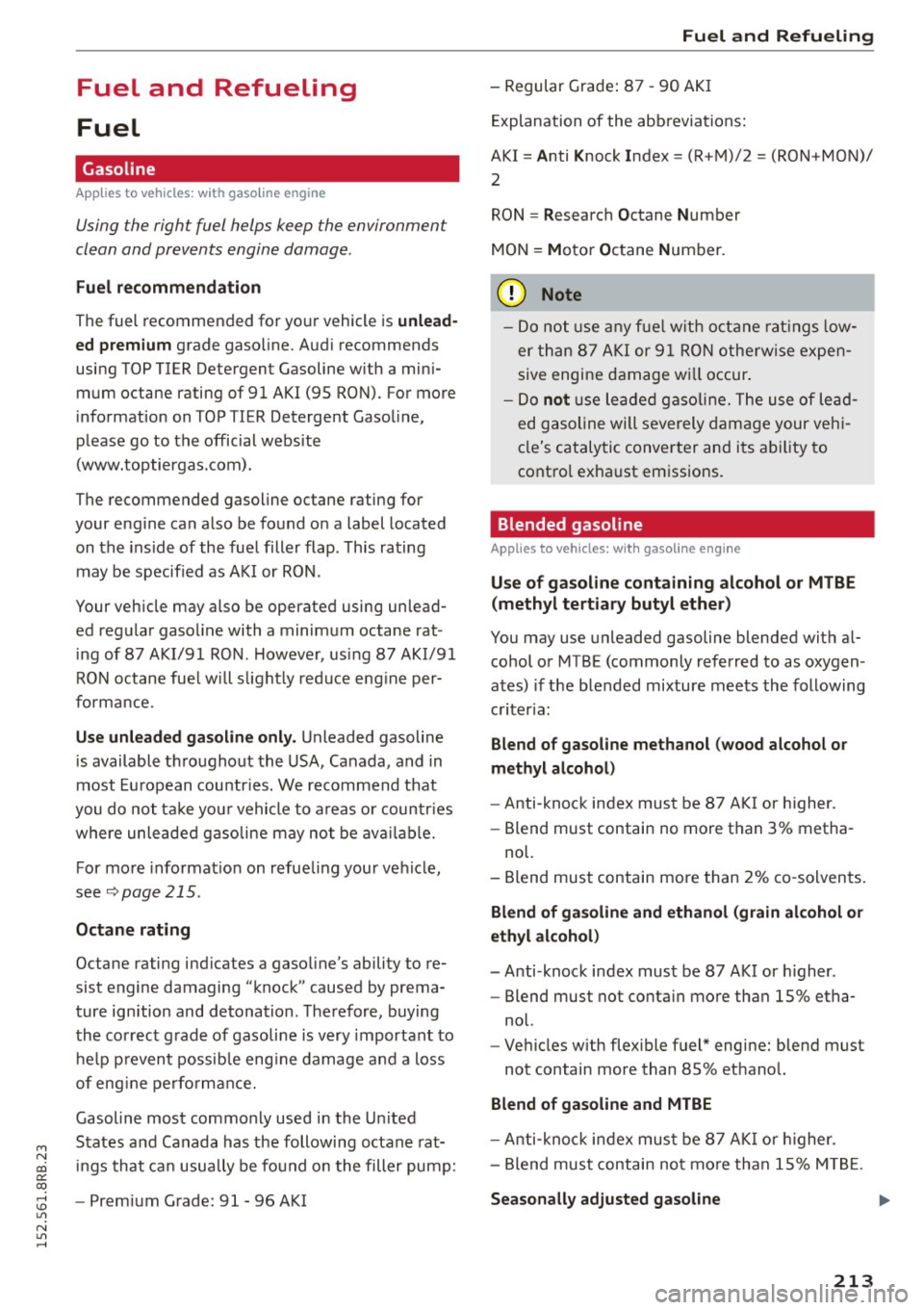
M N
co
a:
co
,...., \!) 1.1'1
N 1.1'1 ,....,
Fuel and Refueling
Fuel
Gasoline
Applies to vehicles: with gasoline engine
Using the right fuel helps keep the environment
clean and prevents engine damage .
Fuel recommendation
The fuel recommended for your vehicle is unlead
ed premium
grade gasoline. Audi recommends
using TOP TIER Detergent Gasoline with a mini
mum octane rating of 91 AKI (95 RON). For more
information on TOP T IER Detergent Gasoline ,
please go to the official website
(www.toptiergas.com).
The recommended gasoline octane rating for
your engine can also be found on a label located
on the inside of the fuel filler flap. This rating
may be specified as AKI or RON .
Your vehicle may also be operated using unlead
ed regular gasoline with a minimum octane rat
ing of 87 AKl/91 RON . However , using 87 AKl/91
RON octane fue l wi ll slight ly reduce engine per
formance.
Use unleaded gasoline only. Unleaded gasoline
is available throughout the USA, Canada, and in
most European countries. We recommend that
you do not take your vehicle to areas or countries
where unleaded gasoline may not be available.
For more informat ion on refueling your vehicle,
see
~ page 215.
Octane rating
Octane rating indicates a gasoline's ability to re
sist engine damaging "knock" caused by prema
ture ignition and detonation . Therefore, buying
the correct grade of gasoline is very important to
help prevent possible engine damage and a loss
of eng ine performance.
Gasoline most commonly used in the United
States and Canada has the following octane rat
ings that can usually be found on the filler pump:
- Prem ium Grade : 91- 96 AKI
Fuel and Refueling
- Regular Grade: 87 -90 AKI
Ex planation of the abbreviations:
AKI =
Anti Knock Index = (R +M)/2 = (RON+MON)/
2
RON= Research Octane Number
MON = Motor Octane Number.
(D Note
- Do not use any fuel w ith octane ratings low
er than 87 AKI or 91 RON otherwise expen
sive engine damage wi ll occur.
- Do
not us e leaded gasoline. The use of lead
ed gasoline will severely damage your veh i
cle's catalytic converter and its ability to
contro l exha ust emissions.
Blended gasoline
App lies to vehicles: wit h gasoli ne e ngi ne
Use of gasoline containing alcohol or MTBE
(methyl tertiary butyl ether)
You may use unleaded gasoline blended with al
cohol or MTBE (commonly referred to as oxygen
ates) if the blended mixture meets the following
criteria:
Blend of gasoline methanol (wood alcohol or
methyl alcohol)
-Anti -knock index must be 87 AKI or higher.
- Blend must contain no more than 3% metha-
nol.
- Blend must contain more than 2% co-solvents.
Blend of gasoline and ethanol (grain alcohol or
ethyl alcohol)
- Anti-knock index must be 87 AKI or higher.
- Blend must not contain more than 15% etha-
nol.
- Vehicles w ith flexible fuel* engine: blend must
not contain more than 85% ethanol.
Blend of gasoline and MTBE
-Anti-knock index must be 87 AKI or higher.
- Blend must contain not more than 15% MTBE.
Seasonally adjusted gasoline ..,.
213
Page 216 of 302
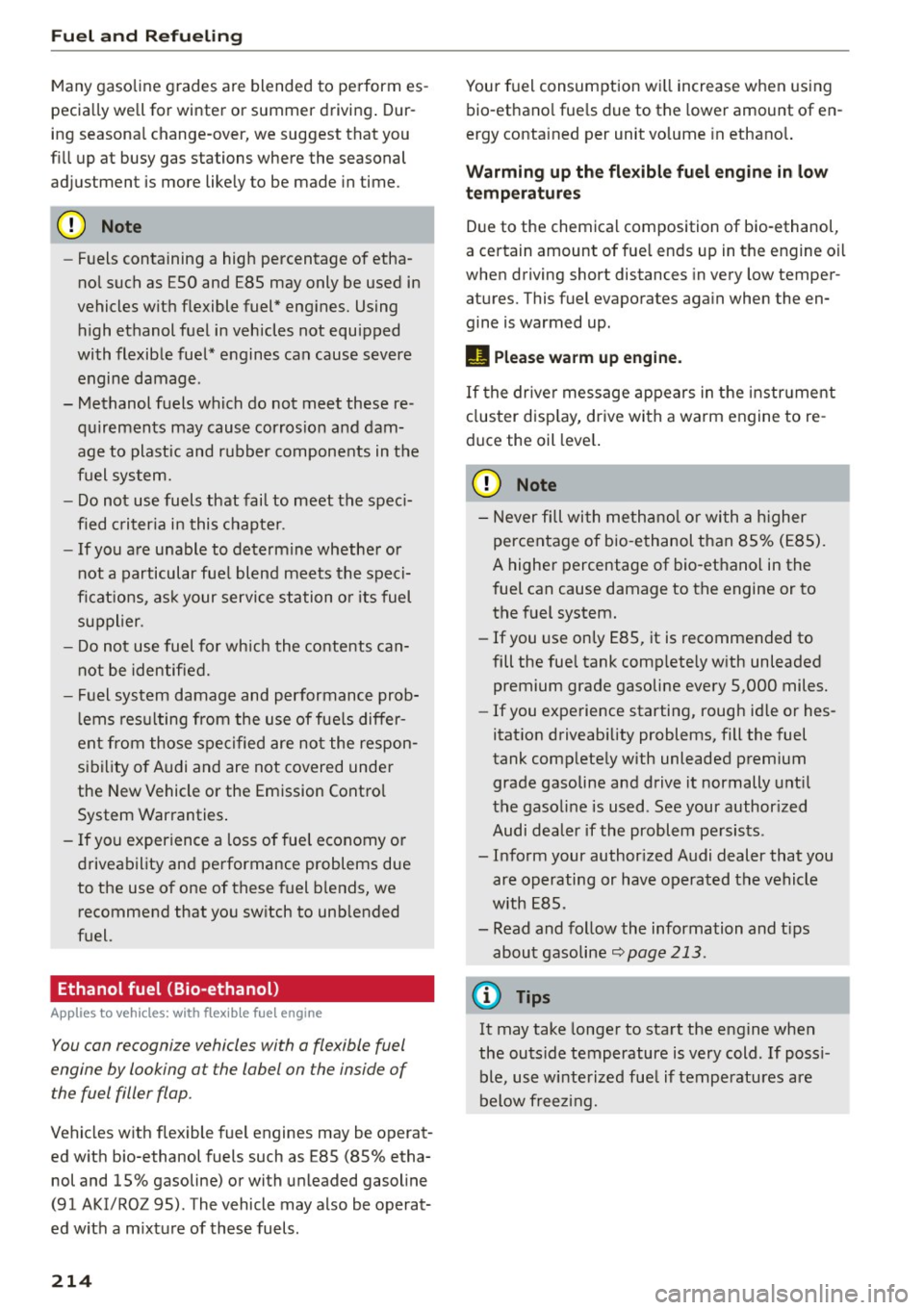
Fuel and Refu elin g
Many gasoline grades are blended to perform es
pecially we ll for winter or summer driving . Dur
ing seasona l change-over, we suggest that you
fill up at busy gas stations where the seasonal
adjustment is more likely to be made in time.
@) Note
-Fuels containing a high percentage of etha
nol such as ESO and E85 may only be used in
vehicles with flexible fuel* engines. Using
high ethanol fuel in vehicles not equipped
with flexible fuel* engines can cause severe
engine damage.
- Methanol fuels which do not meet these re quirements may cause corros ion and dam
age to plastic and rubber components in the
fuel system.
- Do not use fuels that fail to meet the spec i
fied criter ia in this chapter.
- If you are unable to determine whether or
not a particular fue l blend meets the speci
ficat ions, as k your service station o r its fuel
supplier.
- Do not use fuel for wh ich the contents can
not be identified.
- Fuel system damage and performance prob
lems resu lting from the use of fue ls differ
ent from those specified are not the respon
sibility o f Audi and are not covered unde r
the New Vehicle or the Emission Control
System Warranties .
- If you experience a loss of fue l economy or
driveability and performance problems due
to the use of one of these fuel b lends we
'
recommend that you switch to unblended
fuel.
Ethanol fuel (Bio -ethanol)
App lies to vehicles: with flex ible fuel engine
You con recognize vehicles with a flexible fuel
engine by looking at the label on the inside of
the fuel filler flop.
Vehicles with flexible fuel engines may be operat
ed with bio-ethanol fuels such as E85 (85% etha
nol and 15% gasoline) or with unleaded gasoline
(91 AKI/ROZ 95). The vehicle may also be operat
ed w ith a m ixture of these fuels.
214
Your fuel consumption wi ll increase when using
bio -ethano l fue ls due to the lower amount of en
ergy contained per unit volume in ethano l.
Warming up the fle xible fuel engin e in low
t e mperatu res
Due to the chemical composition of bio -ethanol,
a certain amount of fuel ends up in the engine oil
when driving short distances in very low temper
atures. This fuel evaporates again when the en
gine is warmed up.
II Please war m up e ngi ne .
If the driver message appears in the instrument
cluster disp lay, drive with a warm engine to re
duce the oil leve l.
(D Note
-Never fill with methanol or with a h igher
percentage of bio-ethanol than 85% (E85).
A higher percentage of bio-ethanol in the
fuel can cause damage to the engine or to
the fuel system.
- If you use only E85, it is recommended to
fill the fue l tank comp lete ly with unleaded
premium grade gasoline every 5,000 miles.
- If you experience starting, rough id le or hes
itat ion driveab ility problems, fill the fuel
tank comp letely with unleaded premium
grade gasoline and drive it normally until
the gaso line is used. See your author ized
Audi dealer if the problem persists .
- Inform your author ized Audi dealer that you
are operating or have operated the vehicle
with E8S.
- Read and follow the information and t ips
about gasoline~
page 213 .
(D Tips
It may take longer to start the engine when
the outs ide temperature is very cold. If poss i
ble, use winterized fue l if tempe ratures are
below freezi ng.
Page 217 of 302
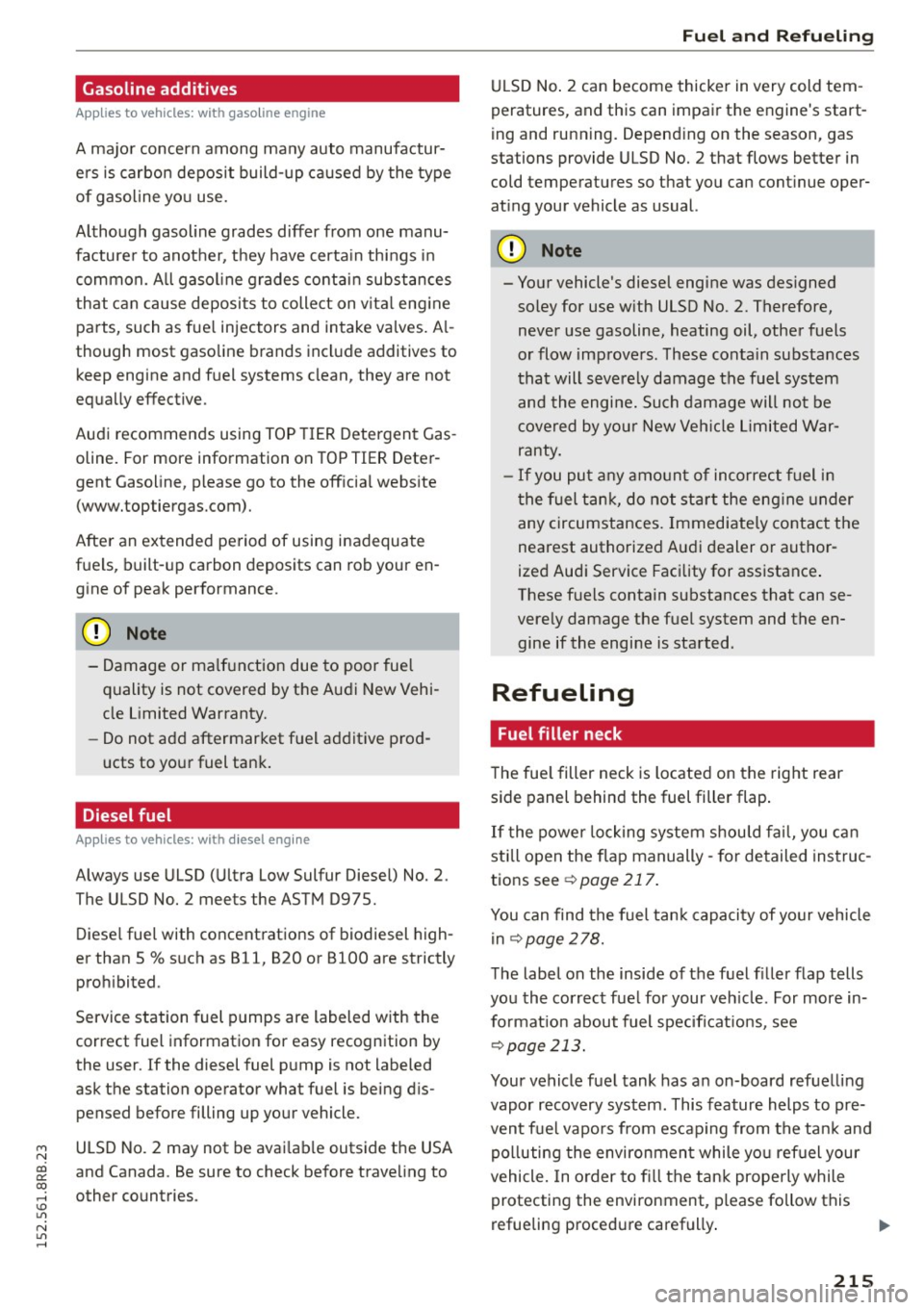
M N
co
a:
co
,...., \!) 1.1'1
N 1.1'1 ,....,
Gasoline additives
Appl ies to vehicles: with gaso line engine
A major concern among many auto manufactur
ers is carbon deposit build-up caused by the type
of gasoline yo u use.
Although gasoline grades differ from one manu
facture r to another, they have certa in things in
common. A ll gasoline grades contain substances
that can cause deposits to collect on v ita l engine
parts, such as fue l injectors and intake va lves. A l
though most gasoline brands include additives to
keep engine and fuel systems clean, they are not
equally effective.
Audi recommends using TOP TIER Detergent Gas
oline. For more information on TOP TIER Deter
gent Gasoline, please go to the official website
(www.toptiergas.com).
After an extended period of using inadequate
fuels, built-up carbon deposits can rob your en
gine of peak performance .
CD Note
-Damage or malf u nction due to poor fuel
quality is not covered by the Audi New Vehi
cle Limited Warranty.
- Do not add aftermarket fuel additive prod
ucts to your fuel tank.
Diesel fuel
Applies to veh icles: with d iesel e ng in e
Always use ULSD (Ultra Low Sulfur Diesel) No. 2.
The ULSD No. 2 meets the ASTM O97S.
Diesel fuel with concentrat ions of biodiesel high
er than S
% such as B11, B2O or B1OO are strictly
prohibited.
Service station fuel pumps are labeled w ith the
correct fuel information for easy recognition by
the user .
If the diesel fuel pump is not labeled
ask the station operator what fuel is being d is
pensed before filling up your vehicle.
ULSD No. 2 may not be ava ilab le outside the USA
and Canada. Be sure to check before traveling to
other countries .
Fuel and Refueling
ULSD No. 2 can become thicker in very cold tem
peratures, and this can impair the engine's start
ing and running. Depend ing on the season, gas
stations provide ULSD No. 2 that flows better in cold temperatures so that you can cont inue oper
ating your vehicle as usual.
CD Note
- Your vehicle's diesel engine was designed
soley for use w ith ULSD No. 2. Therefore,
never use gasoline, heating oil, other fuels
or flow improvers. These contain substances
that will severe ly damage the fuel system
and the engine. Such damage will not be
covered by your New Vehicle Limited War
ranty.
- If you put any amount of incorrect fuel in
the fuel tank, do not start the engine under
any circumstances. Immediately contact the
nearest authorized Audi dealer or author
ized Aud i Service Facility for assistance .
These fuels contain substances that can se
vere ly damage the fuel system and the en
gine if the engine is started.
Refueling
Fuel filler neck
The fue l filler neck is located on the right rear
side panel behind the fuel filler flap .
If the power lock ing system should fail, you can
still open the flap manually -for detailed instruc
tions see
¢ page 217.
You can find the fuel tank capacity of your vehicle
in
¢ page 278.
The label on the inside of the fuel f iller flap tells
you the correct fuel for your veh icle. For more in
formation about fuel specifications, see
¢page 213.
Your vehicle fuel tank has an on-board refuelling
vapor recovery system. This feature helps to pre
ven t fu el vapors from escap ing from the tank and
polluting the environment while yo u refuel your
vehicle. In order to fill the tank properly while
protecting the environment, please follow this
refueling procedure carefully .
215
Page 218 of 302
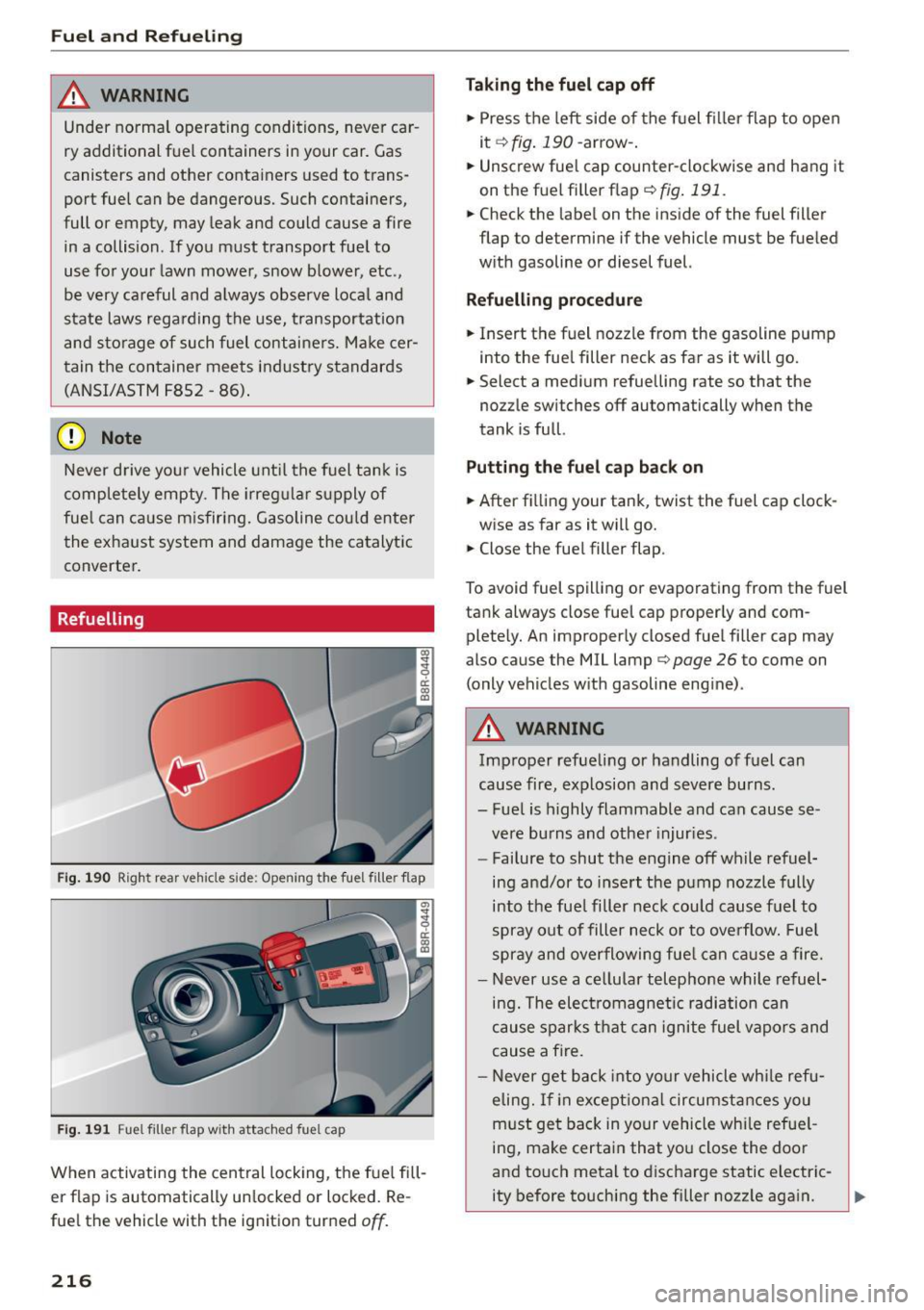
Fuel and R efue lin g
_& WARNING
Under normal operating conditions, never car
ry additional fuel containers in your car. Gas
canisters and other containers used to trans
port fuel can be dangerous. Such containers,
full or empty, may leak and could cause a fire
in a collision. If you must transport fuel to
use for your lawn mower, snow blower, etc.,
be very careful and a lways observe loca l and
state laws rega rding the use, transportation
and sto rage of such fuel containers. Make cer
tain the container meets industry standards
(ANSI/ASTM F852 -86) .
(D Note
Never d rive you r vehicle unt il the fuel tank is
comp letely empty. The irreg ular supply of
fue l can cause m isfiring. Gasoline cou ld enter
the exhaust system and damage the catalytic
converter.
Refuelling
Fig . 190 Right rear vehicle s ide: Opening the fuel fill er flap
Fi g. 191 Fuel filler flap with attached fuel cap
When activating the central lock ing, the fue l fill
er flap is automatically un locked or locked. Re
fue l the vehicle with the ignition turned
off.
216
Tak ing the fu el cap off
.. Press the left side of the fuel fi ller flap to open
it
¢ fig . 190 -arrow-.
.. Unscrew fue l cap counter-clockwise and hang it
on the fuel filler f lap
c;, fig. 191.
.. Check the label on the inside of the fuel filler
flap to determine if the vehicle must be fueled
w ith gasoline or diesel fuel.
Re fuelling proce dure
.. Insert the fuel nozzle from the gasoline pump
into the fue l filler neck as far as it will go.
.. Select a medium refuelling rate so that the
nozzle switches off automatically when the
tank is full.
Putting t he fu el cap b ack on
.. After f illing your tank, twist the fuel cap clock-
wise as far as it will go.
.. Close the fuel filler flap.
To avoid fuel spilling or evaporating from the fuel
tank always close fue l cap proper ly and com
plete ly. An improper ly closed fue l filler cap may
also cause the MIL lamp
c;, page 26 to come on
(only vehicles w ith gasoline eng ine) .
_& WARNING
Imp roper refueling or handling of fuel can
cause fire, explosion and severe burns.
- Fue l is highly flammable and can cause se
vere burns and other injur ies.
-
- Failure to shut the engine off while refuel
ing and/or to insert the pump nozzle fully
into the fue l filler neck could cause fuel to
spray out of filler neck or to overflow. Fue l
spray and overflowing fue l can cause a fire.
- Never use a ce llular telephone while refuel
ing. The electromagnetic radiation can
cause sparks that can ignite fuel vapors and
cause a fire.
- Never get back into your vehicle wh ile refu
eling. If in except iona l circumstances you
m ust get back in your vehicle whi le refue l
ing, make certain that yo u close the door
and touch metal to discharge static electric-
ity before touching the filler nozz le aga in.
IJJ,,,